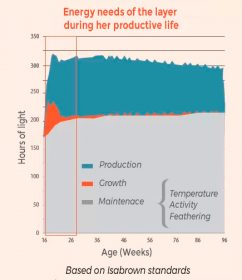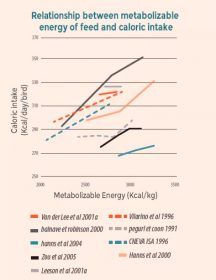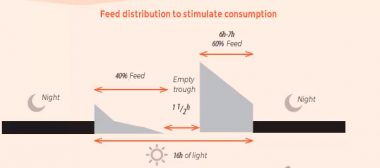To read more content about aviNews España ENG
To read more content about aviNews España ENG
Contenido disponible en:
Español (Spanish)
In a broad sense, the onset of lay phase would comprise the time that elapses from the accommodation of the birds in the production house, until they reach their adult body weight, which in practice would translate into the period of 17 weeks to 30 – 35 weeks of age.
At first, the birds have to overcome the stress of moving and adapting to their new environment. But the fundamental challenge remains to satisfy the nutritional needs of the birds, from the appearance of the first eggs, which increase in size and number exponentially in a few weeks, until final body weight gain has been achieved, which is roughly at 35 weeks of life. Successfully overcoming this challenge will depend on several factors, such as:
Pullets that have a well-developed digestive system and a good ingestion capacity will find it easier to rapidly increase their consumption, which should ideally increase by about 40% between 5% production and peak laying.
Rearing training
The objective of the rearing phase must be to obtain a flock of quality pullets, which can be determined by:
There is often a tendency to think primarily in terms of bird weight and uniformity, and to neglect a fundamental criterion such as the development of intake capacity. In breeding, and from the earliest possible age, birds must be prepared to meet their future needs, getting them used to adequate feeding rhythms, as well as favouring the development of their digestive system.
Regarding the nutritional characteristics of the feed, the one used in the development phase, generally from 10 weeks of age, will have to be a relatively lower concentrated formula (energy level lower than that of the growth formula, but also lower than the formula to be used at the start of lay): High energy levels in this phase will limit the development of the digestive system and present the risk of stopping consumption at the start of lay. It is recommended to dilute the diet with raw materials that provide a high content of insoluble fiber with a thick structure that will favor the development and functionality of the crop and gizzard. Naturally, birds show a greater appetite at the end of the day to cope with nighttime energy needs. In the morning, when the light is turned on, when the digestive system is empty, a peak in feed consumption is also observed. In practice, from 6 weeks of age, it is advisable to adjust the schedules and amount of feed distributed so that the birds consume the complete ration daily, so that the feeders are empty, preferably in the middle of the day, for a period of time which will gradually increase (at least 1 hour).
In any case, very frequent feed distributions should be avoided, since they cause particle selection behavior in birds, causing a greater flock heterogeneity.
Lighting program
It is known that the age at which light stimulus is applied and its amplitude are significant impacting factors on the sexual maturity of layers. On the other hand, the body weight at the time of photoperiod increase will have a determining effect on the weight of the egg, not only at the start of laying, but throughout the laying cycle. However, it is not always kept in mind that another fundamental objective of lighting programs is to promote feed consumption.
In a phase that, as is known, consumption is critical, if the increases in light duration are short or its application too slow and long in time, it will be difficult to achieve this stimulating effect on feed intake.

Figure 1. Example of lighting program and evolution of body weight and consumption (Dekalb White, enriched cage, Netherlands).
In practice, an initial increase of at least 1 h is recommended at the time of lighting stimulation (when the desired body weight and uniformity have been reached based on the desired egg size profile), and continue with increments in the same manner (1 h), at least in the immediate following weeks. Considering that the majority of the lighting programs in production conclude in 16 hours of light, a reasonable objective would be to reach a minimum of 14 hours of light when the flock is at 50% production.
At the start of lay, the main objective will be to meet the amino acid needs for production and growth. However, consumption at the start of lay is limited and must increase rapidly from a low level after transfer —about 85 g— up to values above 110g – 115g in a few weeks – before the peak of lay. This implies that the feed used in this phase must have a higher concentration of amino acids than that which will be used in later production phases, adjusted to the consumption of feed observed on the farm, but also to the daily mass of eggs produced —percentage of laying x average weight of the egg— which is the factor that has the greatest impact on amino acid needs.
Especially when the uniformity of the flock is not enough, the challenge is to formulate feed adequately to cover the needs of the most productive birds and allow the development of the most delayed ones. Depending on the uniformity, it may be advisable to use a safety margin for amino acids, at least for methionine, of approximately 6% above the recommended levels. With this strategy, a maximum use of sulfur-based amino acids is also favored to promote a rapid increase in the weight of eggs, since in this starting phase of laying is when the nutritional modifications have the greatest effect on their size.
Promoting energy consumption
Unfortunately, during the 18-25 week period, the birds’ consumption capacity is limited and they are not always able to meet the rapidly increasing needs for energy and other nutrients (Figure 2), which can result in insufficient hen growth and unsustainable peaks in production.

Figure 2. Layer’s energy needs during its productive life.
At the beginning of lay, it is a priority to reach adult body weight soon, which means robust birds, with greater opportunity to maintain a good persistence of laying during the laying cycle and with better responsiveness to possible challenges or stress factors (sanitary, environmental, management, etc.).

Figure 3. Relationship between metabolisable energy of feed and caloric intake (several experiments).
Although many studies have shown that layers are able to regulate their feed intake (g/bird/day) quite well depending on its energy concentration, this regulation is not perfect, and in general a higher energy consumption (expressed in Kcal/bird/day) is observed when diets with high levels of metabolizable energy are used (Figure 3).
A controversial issue is the recommended energy level during this phase to achieve these goals.
Energy consumption is higher when using diets with high levels of metabolizable energy. This is partly due to the fine-binding effect and favourable palatability of the addition of oils and/or fats, which are the raw materials that enter in greater proportion in the more concentrated formulas. This effect can always be exploited and a more concentrated formula can be used at the start of laying to promote energy consumption and growth, especially in those flocks whose previous handling has not been favourable to the development of their intake capacity. It is essential to continue weighing the birds regularly at the start of lay, up to 35 weeks of age, so that nutritional or management adjustments can be made if deviations from the target are observed.
Feeding techniques
Chickens are granivorous, and will always prefer coarser particles to finer ones.
A relatively frequent error observed at farm level, especially when consumption is low, as is the case in the initial laying phase, is an excess of feed distribution. Overly frequent distributions encourage selective feeding behaviour of the birds and as a consequence the accumulation of fine particles in the trough. As described for the rearing phase, in production it is also essential to achieve a period in which the trough remains empty every day, thus forcing the birds to also consume the smaller particles, which contain most vitamins and minerals, ensuring a well-balanced nutrition.
Taking into account the behavior of the hens, their physiology and the daily cycle of egg formation and especially of the shell, in production it is advisable to guarantee greater consumption in the hours preceding the night, so that approximately 60% of the the total daily ration is consumed in the afternoon, and the rest in the following morning, so that during the middle of the day the feeder is empty, with a maximum duration of 1 h and 30 min (Figure 4).

Figure 4. Feed distribution technique to stimulate consumption.